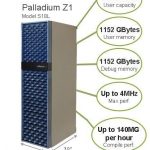I’ve mentioned many times what has become a very common theme in SoC and system verification – it has to be driven by the software because any concept of exhaustively verifying “everything” is neither feasible nor meaningful. Emulation has become a critical component of this flow in validating and regressing… Read More
A (R)evolution in Hardware-based Simulation Acceleration
The most exciting products in our industry are those that are both evolutionary and revolutionary. Cadence has just announced an update to their hardware simulation acceleration platform – Palladium Z1 – which continues the evolution of the unique capabilities of processor-based acceleration, plus a revolutionary approach… Read More


